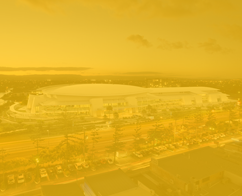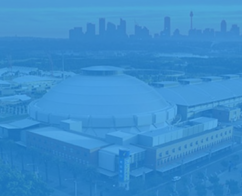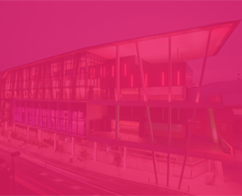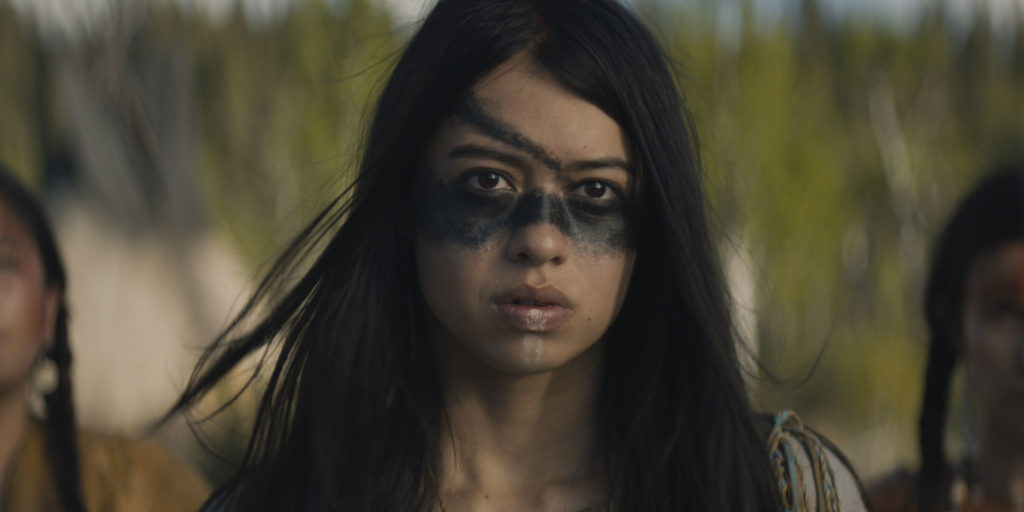
Prey – the newest film in the Predator franchise – teleports fans back in time to the Comanche Nation of 1715. It introduces us to Naru, a strong-willed, fierce and skilled warrior who’s out to prove herself to her Elders. Raised on the Great Southern Plains of America by a community of legendary hunters, Naru wastes no time coming to the defense of her people when an extraterrestrial threat looms large on the horizon. Prey depicts the Predator species’ first hunt on Earth, and the creature itself is very different to any we’ve seen before in the franchise.
When asked about this new breed, Prey’s director Dan Trachtenberg (10 Cloverfield Lane) excitedly explains that, “We wanted to make a Predator that felt much more alien, much more creature, more ferocious and feral than we had ever seen before. In doing so, part of the design was like, okay, then it can’t be as armoured because we want to really feel its flesh and see its skin.”
This created a challenge for the team, because the film is set 300 years prior to the previous entries in the series. Trachtenberg says, “We needed to understand that though it’s older, it still has a very advanced arsenal that would be formidable for any Earthling to encounter. We had to put all of that design into the weaponry because the armour could not tell that tale.”
Prey expands the Predator lore in a big way, but getting the creature right was the easy part. The filmmakers also committed to making sure the movie provides a historically accurate portrayal of the Comanche, bringing a level of authenticity that would feel genuine to its Indigenous peoples. This meant gathering a cast of incredible Native American and First Nations talent.
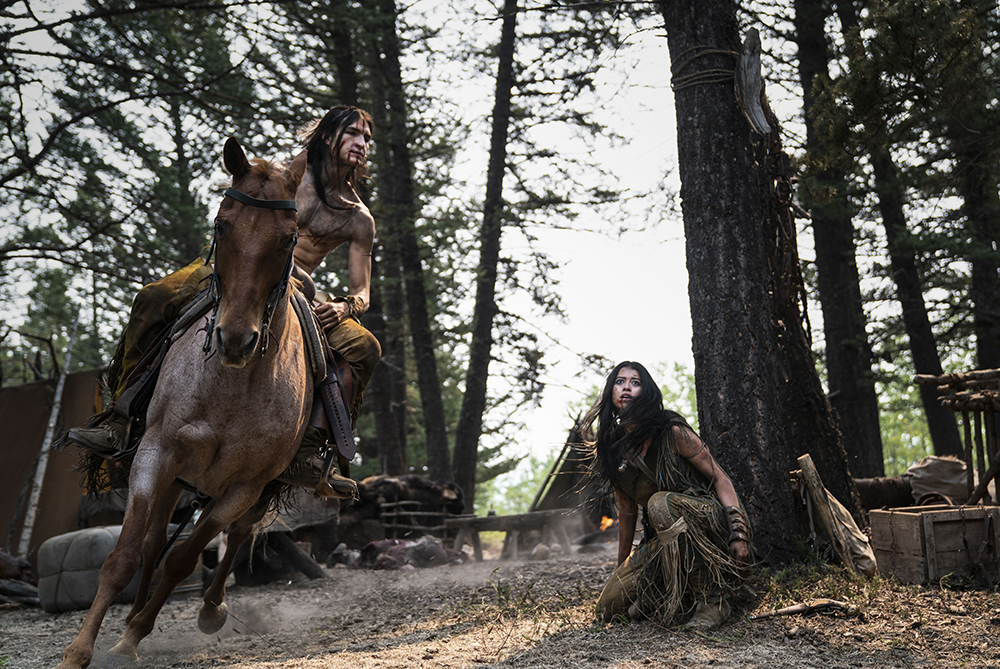
L-R: Dakota Beavers as Taabe and Amber Midthunder as Naru in ‘Prey’
Naru is played by actress Amber Midthunder (Legion, The Ice Road) who did her own research and preparation to ensure her character rang true with the Comanche community. “Naru lives in 1719,” she says. “I guess that sounds like it’s a long time ago, but in history, it’s not really that long. When I think about my ancestors who were here and living in that time, the preservation of their culture is a big conversation in Indigenous communities, and so there are things about that time period that feel really close. Other things about that time feel really far, which is what we’re fighting to preserve.”
Luckily for Midthunder and the rest of the cast and crew, they had the expert guidance of the film’s producer, Jhane Myers, to lead them on the right track.
Myers, who is also a fine artist, states that she took every step that she possibly could to portray Comanche culture of the early 1700s accurately. She explains, “I’m Comanche myself and I’ve worked within the museums and collections of history, language, song and dance. I was using all of those tools in order to make sure that we had the right mix, but also to bring in new faces and put Native people in positions where they normally wouldn’t be.”
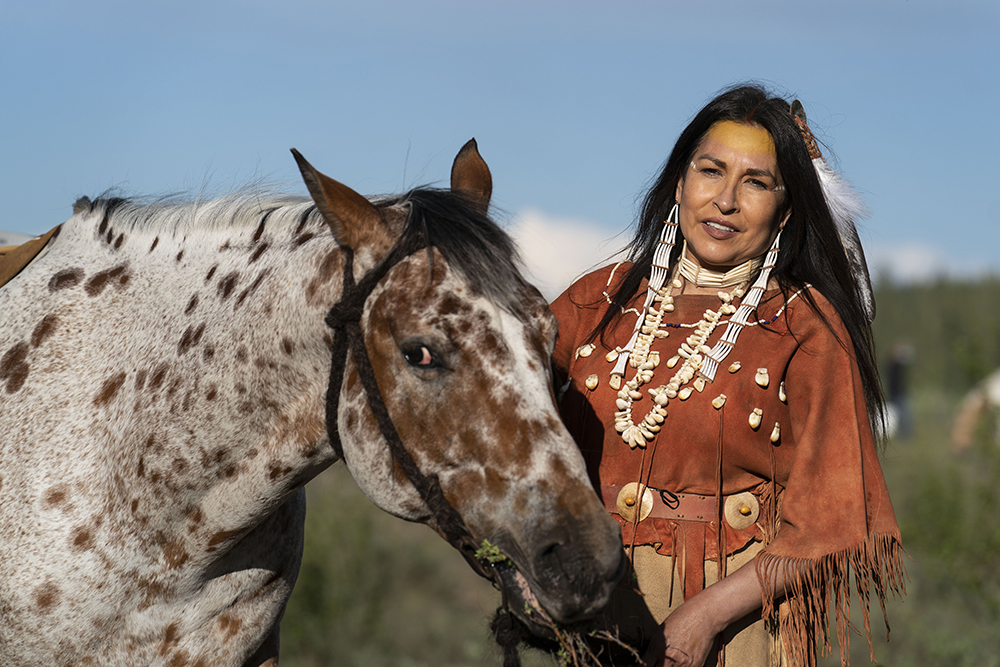
Executive Producer Jhane Myers behind the scenes of ‘Prey’. Photo by David Bukach
Midthunder speaks very highly of Myers’ hands-on approach to producing: “She was there every day of prep, every day of shooting, and every day since then, just making sure that we were there and if we had questions, they were answered or that we were kind of living up to everything that we possibly could as far as getting the representation right. And then there’s physical stuff like weapons training, with the focus on Comanche war style and that sort of thing.”
The Comanche and Native American influence extends well beyond the main cast of the film. Myers says, “Whether it’s the composers, or the artists who made the paintings over the credits, I wanted to make sure everything was authentic.”
When the film streams on Disney+, it will also be available with an optional audio track dubbed entirely in the Native language. “My favourite part is the dub in Comanche,” Myers says. “That’s really important, because we’ve never had a film in my language… in Comanche.”
When we mentioned it would have been great if the film was shot entirely in Comanche from the get-go, Myers’ face lights up. She then prompts Trachtenberg to explain why they didn’t.
“That was the initial intention,” Trachtenberg says. “It was what we wanted to do, but as we evolved, we realised there’s a lot of power in feeling like we’re all – at least the English-speaking part of the world – linked to Naru through language. Then, when we encounter the French-speaking fur trappers, they’re as foreign to her as they are to us. Getting to do this thing where we have no subtitles for the trappers makes it – I think – a powerful moment. But then we have this awesome dubbed version that you can choose to watch with the entire cast returning to record their lines.”
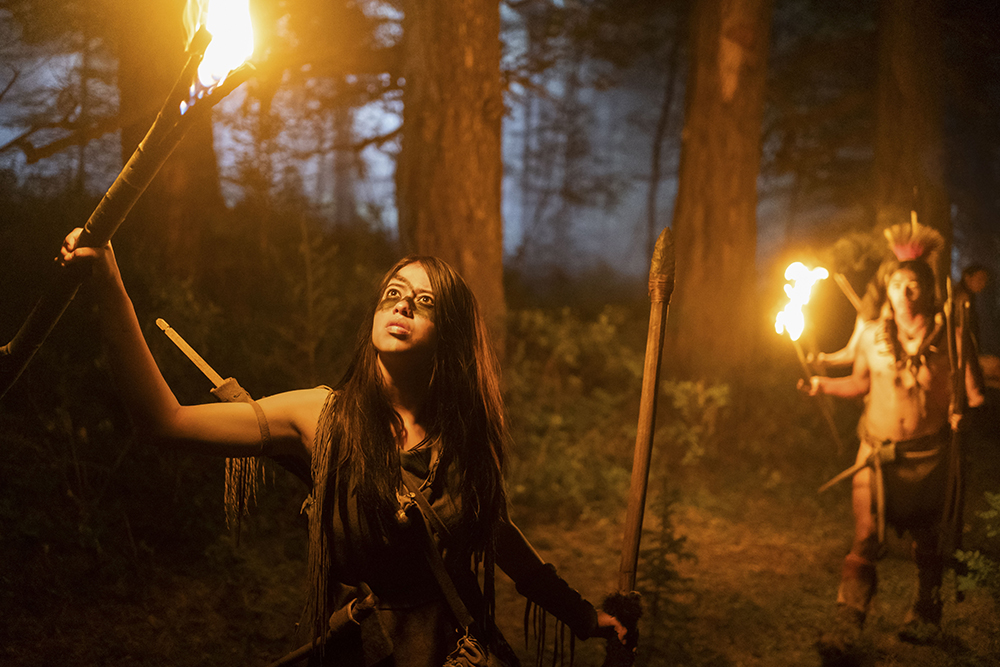
Amber Midthunder as Naru in ‘Prey’. Photo by David Bukach
In building the audience’s link with Naru, we also meet her brother Taabe, a more experienced Comanche hunter, played by first-time actor Dakota Beavers. When asked how he and Midthunder developed their onscreen sibling rivalry, Beavers says, “It was really cool because we got to do this four-week boot camp with Amber, myself, and the boys in the movie. We all got to kind of bond and hang out. We hung out weekly. Every weekend, pretty much. So we got to bond, learn each other’s wavelengths and work on how we communicate.”
Midthunder needed to bond with more than the human cast, as her character Naru finds herself in the wilderness, tracking the alien creature with the only help being from her dog, Sarii. Naru’s friendship with Sarii almost becomes the heart of the film, but offscreen their relationship may have been a little more complicated.
“That dog was crazy!” Midthunder exclaims. “They adopted her two months before filming because they found her breed to be the most accurate for the location and the time period.”
Typically, animals used in movies go through a lengthy regime of training beforehand. “She just got thrown in there,” Midthunder says. “And man, I love her. She was so high energy. She happened to be the most high-energy dog you could ever find in the world, and then she got put on a movie set, which is wild.
“A lot of her being around was like, ‘Coco, come back! Coco, where’d you go? Coco, don’t jump off a cliff!’ A lot of crazy stuff like that. But then she ended up being so great in the movie. People really love her and I think it’s amazing.”
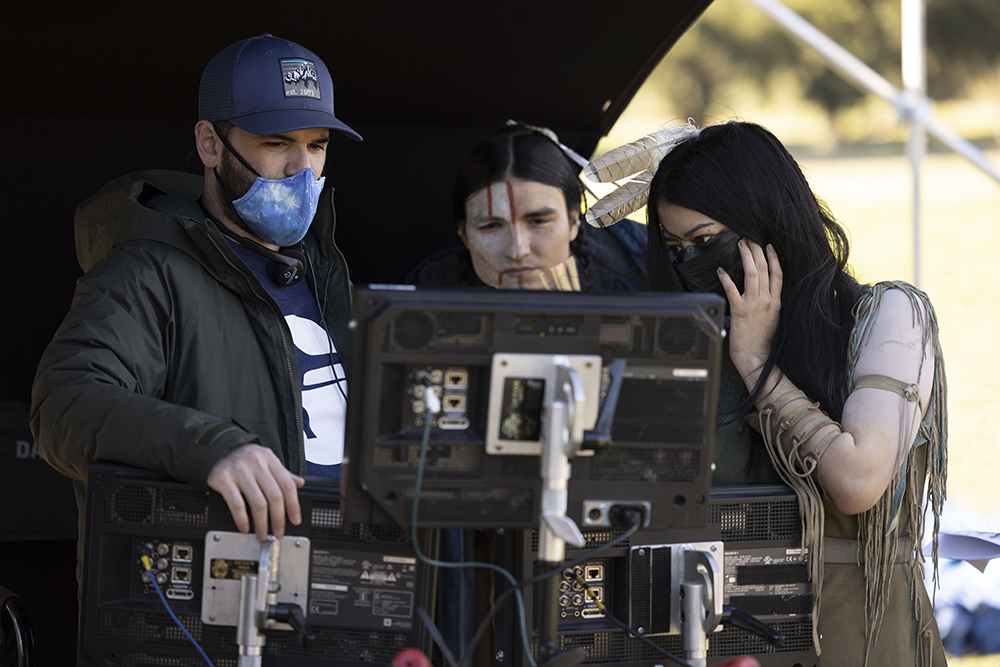
L-R: Director Dan Trachtenberg, Dakota Beavers, and Amber Midthunder
Midthunder wasn’t the only one afforded the opportunity to work with animals on the set of Prey. Beavers says that his favourite part of the experience involved horse riding. “I always talk about the horse scene because I enjoyed riding that horse so much,” he says, smiling. “I told Steve (the stunt coordinator) I wanted to do all my own stunts and riding if I could. He said okay, so I got to riding that horse.
“Obviously you don’t see it, but there’s like a hundred people, and the track for filming is so small,” he says. “You realise how good this horse is that you’re riding. Whenever he’s not getting spooked by the wires and the flashing and the noises and the people. It’s pretty intense.”
Much of Prey was shot on location in Alberta, Canada, and the landscape put some harsh physical requirements on the cast. In one scene, Naru finds herself stuck in quicksand. When asked about the experience, Midthunder says, “Oh God, it was awful! We shot that over, at least a week. And, I mean, it was just like, show up to work, get in the mud.
“I don’t know how they made it, or what it was made of, but it was really thick. You would touch it and your hand would be covered in it.” Midthunder pauses briefly, then continues. “And it smelled like poop. It smelled like fertiliser. I was like, ‘I don’t understand what this is.’ I don’t know if Dan was playing a prank on me. He just really wanted me to be in the moment but, yeah, it was quite the experience.
“Afterwards, I would stand in a horse trough that had a chair in it, and four women would hose me down. Then we would go do it again, and I would do it over and over and over. Then we’d break for lunch, and then it would be nighttime, and I would go and shoot the big fight scene and then come back and do it the next day.”
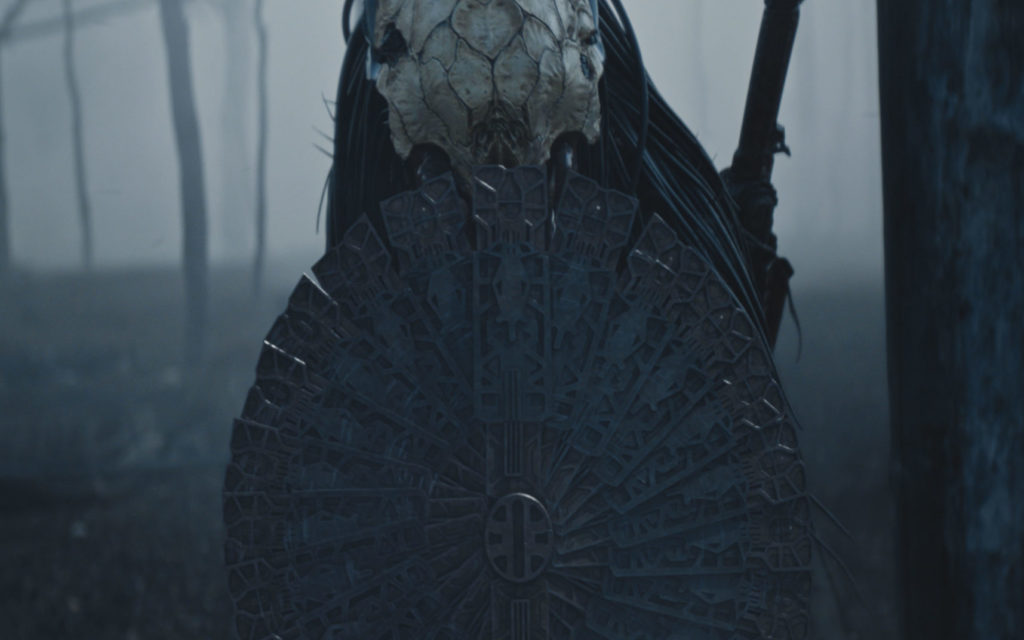
Dane DiLiegro as the Predator in ‘Prey’
While Midthunder’s battle with the mud was relatively low-tech, the fight scenes with the creature were anything but, proving just as challenging for the actors but in different ways. Beavers explains, “During my fights – and most of Amber’s – she’s fighting with a guy in a suit, and they add special effects over the top of him. Sometimes what you see on screen is what you see in real life, so you can kind of act on that. But then fast forward, we do some reshoots in L.A. and Santa Clarita, and you’re acting with a blue screen, so you kind of get a taste of how big movies work now. It was a nice taste of both worlds.”
Similar to the shooting experience, the design of the creature in the Predator films has always been borne from a mix between high-technology and its primal nature. Prey highlights this dichotomy of design more starkly than ever. Trachtenberg says, “I love the concept of this bone mask thing the creature wears in Prey. We iterated with the awesome folks over at Amalgamated Dynamics (a special effects studio), which is headed by the great Alec Gillis and Tom Woodruff Jr. who made all of our favourite movies growing up.”
Trachtenberg is confident that he and the team have presented a creature that will appeal to fans, saying, “We made this version of the Predator that I think is undeniably Predator and yet totally new, and the most different that it’s ever been. Hopefully people will be excited. Not just people that have never seen any of these movies, but even diehard fans get a treat and see something new.”
Prey is an original film streaming August 5 on Disney+ under the Star banner.
LEAD IMAGE: Amber Midthunder as Naru in ‘Prey’



